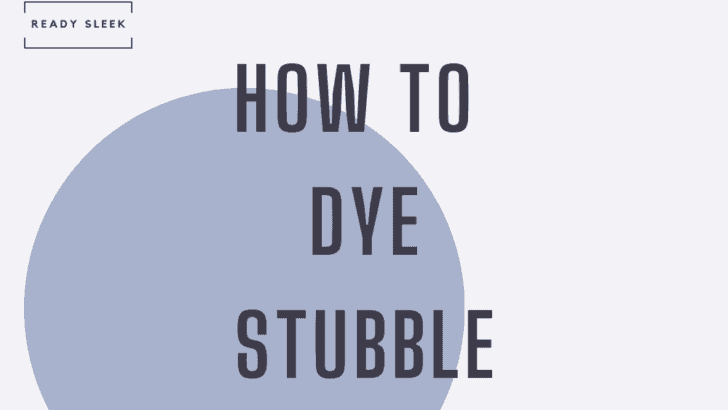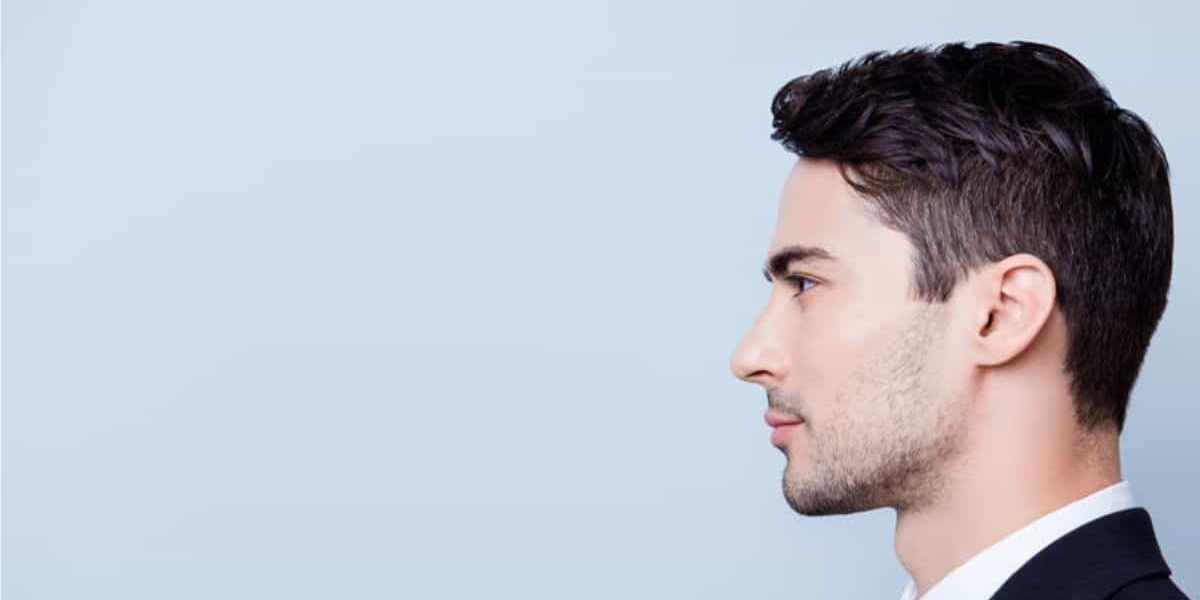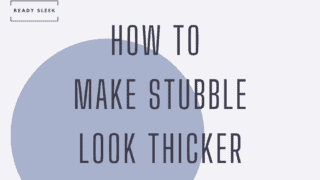Dyeing stubble is a surprisingly valuable skill. It isn’t easy, though.
You’re about to learn everything you need to know to do it yourself. We’ll go through everything in detail. But first, in a nutshell, how do you minimize staining?
To dye a stubble beard with minimal staining, be sure to apply the dye using a precise applicator such as a small brush. Having cleaning wipes at hand to swiftly remove dye from these areas during the process will also help. Using gloves is a simple way to avoid unnecessary staining of the hands.
There are several reasons a man may want to dye their stubble; all of them aesthetic, and each of them admirable in their own right.
But dying stubble does come with its pitfalls including underwhelming results and noticeable skin staining if done incorrectly.
Before we move on it’s important to understand that some mild staining of the skin is inevitable, but often hardly noticeable. Follow our routine and you’ll be just fine my stubbled warrior.
Say goodbye to gray or patchy bristles. Let’s walk through it step-by-step.
By the way, if you’re looking for other products that could also take your stubble to the next level, check out this article too.

3 types of men that may want to dye their stubble
There are multiple reasons a man may have for learning how to dye stubble. But they would usually fall into one of three categories, although there is almost always some overlap between them.
1. Men with gray stubble who want to look younger
These men learn how to dye their stubble for the simple reason of wanting to regain their previous, youthful color.
It’s perfectly reasonable and there’s absolutely no shame in it. Why should it carry any more stigma than dyeing scalp hair?
The practice is gradually becoming more and more common in the ever-expanding field of men’s grooming.
In today’s modern beard renaissance, it seems to be a very natural progression.
The results can be phenomenal, making a man look years younger when done correctly. A considerable increase in confidence and self-esteem is often seen.
2. Men with patchy stubble
Stubble can look patchy for different reasons. The cheeks are often thinner than the chin and mustache.
Another reason is variation in color, with some hair shafts considerably lighter than neighboring ones.
This variation can cause or exacerbate patchiness and is something fairly easily corrected by using a good dye to get a more uniform color.
Dyeing stubble a darker color can also make the underlying skin less noticeable, making it look even less patchy.
Patchy stubble can also kill a man’s confidence. Thickening it up could transform a man from timid and shy to Spartan warrior if done correctly.
3. Men who want to change it up
There are those men who have naturally dark stubble with good volume and still want to dye it. You may be thinking, why on earth would they want to do that?
Well, one reason could be that they’ve never really liked the color and want to change it up.
Remember, beard hair is notorious for doing whatever it wants.
It’s not uncommon for a man’s beard hair to be a noticeably different color to their scalp hair. Learning how to dye their stubble may be the exact solution to this frustrating problem.
Another reason, although less common, is that they want to change up the color for novelty reasons.
For example, dyeing it blue for a bachelor party or sports event. You’d need to be a pretty confident beardsman to pull this off, but these people do exist and good for them.
The 2 main subtypes of stubble dye
Let’s get down to the nitty-gritty as we approach our step-by-step walkthrough. It’s important to understand the basics before we launch right into it.
There are two main subtypes of beard dye – temporary and permanent.
When just starting, I’d recommend temporary. It’s comforting to know you can make mistakes on your first few tries and not have to live with the outcome for too long if it goes wrong.
Factors such as dye color, as well as technique are things you’d want to hone with temporary dye before committing to a permanent dye.
Permanent dyes
These are designed to last for several weeks (semi-permanent) or even a few months (permanent) once they’re applied. Although they aren’t permanent in the same way a tattoo would be, they are difficult to remove once applied.
There are some benefits of using permanent dye other than the fact that you don’t have to go through this process so often.
Permanent dyes also generally have a wider range of colors to choose from. It’s just important to get the right one considering its longevity.
They also aren’t nearly as sensitive to environmental or external pressures such as rain, washing, and drying.
Temporary dyes
It’s ideal for men just starting to learn how to dye their stubble, as it leaves a lot of scope for natural error. This is because it’s fairly easy to wash off with shampoo and has a lifespan of around 12 – 24 hours.
But it’s also completely fine to stick with temporary dyes even when more experienced. A lot of men don’t want a permanent dye, and only want to touch up their grays before special occasions.
Tips on choosing stubble dye color
Unless a man is looking for a more advanced, quirky variation, people generally want their stubble color to match their scalp hair. Unless they’re bald, in which case it’s less important of course.
Other men simply wish to color their gray stubble the same color as their normal stubble.
The number one tip is to be skeptical of the color a dye claims to give. It’s universally accepted that the color stated on the product box is almost always inaccurate.
Because of this, it’s usually best to choose a dye color one or two shades lighter than the color you want.
How To Dye Stubble – A Stepwise Routine
It’s showtime. Let’s launch into the walkthrough.
Step 1: Perform a simple patch test
Not all dyes contain the same ingredients. There may be some beard dyes your skin reacts to.
Always carefully check the ingredients of your dye and consult a clinician if you have any concerns prior to applying the product.
A patch test is always recommended before you use the dye. It’ll usually give you instructions in the specific product’s manual.
Step 2: Trim your beard the way you want it
Before you pick up that dye, trim your beard the way you want it. It’s preferable to do this before dyeing your stubble because you only want to apply dye to areas of your face and neck that will be bearded.
If you apply dye to areas of your stubble you are just going to shave off minutes later, you’ll risk staining the skin where you didn’t need to.
If you’re looking for a stubble trimmer, try the Philips Norelco Oneblade QP652070. It gives you very precise control at these short lengths. Check them out on
We’ve got plenty of tutorials on how to trim a stubble beard, so we won’t be elaborating on this step.
But be sure to carry out this step before moving on.
Step 3: Cleanse your face
You’ve hopefully already done this as part of your trimming routine.
Leaving natural oils on the surface of the skin often repels the dye and prevents it from taking effect properly.
So, consider using a good cleanser.
Step 4: Prepare the dye (if you need to)
Now that it’s time to start handling the dye, put those disposable gloves on. Also, ensure that you’re wearing a T-shirt you don’t mind getting stained.
Some dyes, particularly temporary ones, come as pre-prepared solutions. If that’s the case, this step can be ignored.
Simpler Hair And Beard Dye is great because the container comes with two nozzles that simultaneously release the base color and developer onto the brush. It mixes on your beard itself as you apply it.
But many semi-permanent and permanent ones often need to be mixed manually in a tray before you apply it.
For the purposes of this tutorial, let’s assume you need to mix your dye.
These dyes usually come in the form of two tubes: the base color and the color developer. The base color is the actual coloring agent, and the developer simply thickens it into a paste that can be applied.
The amount you mix shouldn’t be very much, considering you’ll only be dyeing a stubble beard. Mix just enough to go over it once. You can always mix more dye later if necessary.
Every product will have its own application method, however, so be sure to check the instructions carefully.
Step 5: Apply the dye on your stubble
Be sure to dye your patchier, thinner, or grayer areas first. You’ll want these areas darker.
As we said before, the longer the dye is in contact, the darker the hair will be.
You can apply it throughout your entire beard. However, some men do prefer to aim for a blend of gray hair and dyed hair for a more natural look. This is something you can experiment with.
Most people don’t notice it as these areas are covered by stubble hairs in any case.
It’s inevitable that in the dyeing process you’ll accidentally smear a bit of dye outside the borders – for example below your neckline or above your cheek line.
Be vigilant and use cleaning wipes to remove it before it stains.
Step 6: Assess the color
The product box will almost certainly give you a recommended time to leave the dye on. It’s usually around 5 minutes, so be sure to time yourself!
At the 5-minute mark, it’s often a good idea to test out the color. Take a cotton bud, or piece of tissue, and remove a little bit of the dye from your stubble.
Assess the underlying color. If it isn’t dark enough, apply some more dye and give it another 2-3 minutes. Then repeat. Once you’re happy with the color, move on to the next step.
Remember, the hair will get darker the longer you leave it in contact with the hair.
If you feel as though the stubble is too dark, don’t panic just yet. The color will fade a little after washing it.
Step 7: Wash with shampoo
Again, the product you’re using should have instructions regarding when to wash the dye off. Follow it carefully.
Ready Sleek founder. Obsessed with casual style and the minimalist approach to building a highly functional wardrobe. Also a fan of classic, vintage hairstyles.







